North American Pitcher Plant
The North American pitcher plant or Sarracenia makes an excellent specimen for the container garden. There is a small variety of species and considerably more hybrids. As the name suggests these insect-eating plants hail from North America. They are very easy to grow carnivorous plants. Their requirements are specific but very straight forward. Stick to the path and you wont have any problems.
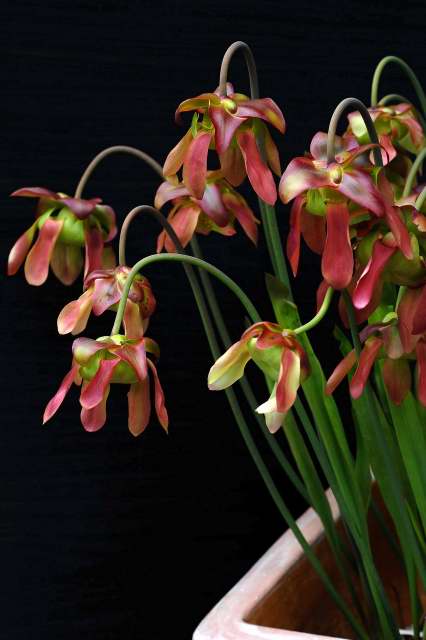
Flowering Sarracenia hybrid
The requirements for trouble free cultivation of North American pitcher plants are:
- Nutrient-free, slightly acid soil.
- Rain water.
- Full sun.
- Cool winter period.
Soil requirements for Sarracenia sp.
Most pitcher plants originate from boggy peat lands. Their ideal growing medium is a 50:50 mixture of spahgnam peat moss and lime-free sharp sand.
Water requirements for Sarracenia sp.
Grow carnivorous plants in soil that is permanently wet. Ideally the water used should be rainwater. You may live in an area with soft water which may be safe but why risk it. Most tap and bottled water will kill North American pitcher plants. Invest in a water butt or rain barrel. This will cater for all your requirements.
Growing insect-eating plants within containers filled with rain water is the easiest way to achieve this level of dampness. Standing the pot containing the pitcher plant inside another container provides a greater reservoir of water. This also reduces the risk of the plants drying out.
Sarracenia like to stand in water that is just below the soil level. To achieve this, it may be necessary to stand the carnivorous plant on something within the container. An upturned ceramic flower pot comes in handy for this. The aim is for the rim of the pot containing your insect-eating plant to be just below the rim of the container. It is more pleasing to the eye if the pot does not stick out of the top.
The plants however do not wish to be submerged. During periods heavy rain your carnivorous plant may get flooded. If this happens tip some of the water from the container. Alternatively you can drill a small hole in the side of the container. This will work in the same fashion as a bathtub overflow.
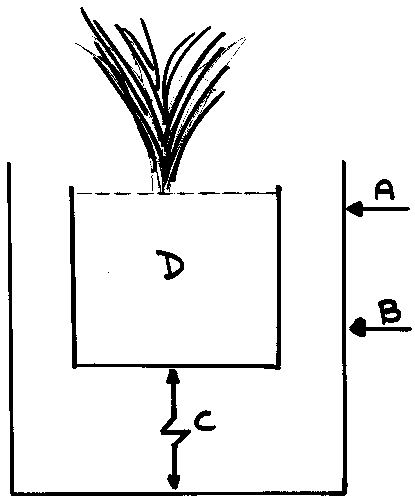
- A represents where you should drill a hole should you wish to grow sarracenia.
- B represents where you should drill a hole should you wish to grow Venus fly traps.
- C represents the distance you may have to raise your pot within the container.
- D is your carnivorous plant of choice.
.
You can grow a carnivorous plant directly in a soil filled container. However this puts the plant at a greater risk of drying out. You will constantly have to top up the container with water bearing in mind that the plants like to be grown in full sun.
Light requirements for Sarracenia sp.
North American pitcher plants naturally grow in open country. They prefer a spot with maximum sun in the summer but also require low light levels during the winter months. Unfortunately this means that they are not really suitable for permanent indoor cultivation.
Hardiness of Sarracenia sp.
The majority of trumpet pitchers originate from south-eastern USA (zone 8) and can take a good bit of cold. Some pitcher plants such as Sarracenia purpurea purpurea can take extreme cold, living as they do in parts of Canada. This is very useful as you will not have to clog up the greenhouse overwintering these plants. Pitcher plants need a period of cold weather during the winter. If they are grown in a conservatory during the summer they will need to spend the winter outdoors. They look a bit rough during this phase anyway. They are completely hardy in a zone 9 garden.
Growing carnivorous pitcher plants from seed
Sarracenia seeds are widely available from seed catalogues. You don't get many in a packet but they germinate quite easily. The trick to getting them to germinate is to make them think that they have experienced winter.
- Fill a wide plastic flower pot with a 50:50 mixture of sphagnum peat moss and lime free sharp sand.
- Fill a kettle with rain water and boil it.
- Pour the boiling rain water gently over the soil mixture to sterilize it. Allow it drain and cool.
- When the soil has cooled completely, press the seeds in to the surface of soil. Do not crowd them as they will spend a couple of years in this pot. Five seeds to a pot is fine. Do not cover the seeds.
- Place the pot inside a freezer bag and seal.
- Place the pot in the fridge for 2-3 months. The pots can be placed outdoors for the winter but I would recommend using the fridge. Do this to coincide with winter so that the seeds come out in early spring.
- Remove the pots from the fridge in mid march.
- Remove the bags and place the pots in a container filled with sterilized rain water. The water level should be at about half the height of the pot. Ideally this should take place in a greenhouse but any bright window sill will do. Germination should occur within a few weeks.
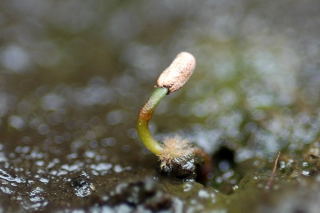
Newly germinated Sarracenia Leucophylla
The newly emerged plants will grow slowly in their first year and should have 2 or 3 pitchers measuring an inch or so by the end of the first season. The only care they require is to be sure the container never dries out. During the winter when Sarracenia enter a period of dormancy, the little pitchers will start to turn brown from the top. Do not panic as this is quite normal. During this first winter the surface of the pot may well develop a layer of moss. This needs to be removed to prevent the moss swamping your baby plants. This can be achieved using a pair of long tweezers. If you pull up a baby pitcher plant by mistake, untangle it from the moss and put it back where it came from.
.
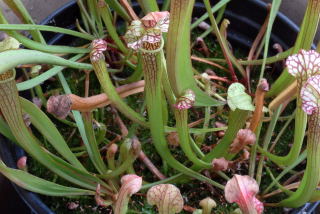
Sarracenia Leucophylla at three
After a couple of years the baby pitcher plants will be ready to prick out. In the case of slower growing Sarracenia Leucophylla it is more like three.
(This picture shows why you don't really want more than about five seeds to the pot.)
.
Pricking out Sarracenia sp.
Once your plants are big enough to handle.
- At the end of winter, but before growth begins, clean off any moss that will have grown.
- Prepare 3inch plastic flower pots with a 50:50 mixture of sphagnum peat moss and lime free sharp sand. (One for eachplant.)
- Remove the small sarracenia from the pot. It may be easier to cut the pot to minimise damage to the pitchers. Place the pot-less clump of plants in a bowl of rain water. Agitate the clump in the water to dislodge the soil. This will make the plants easier to pull apart.
- Plant each plant individually in their new pots.
- Place the pots in a plastic grave tray and fill it with rain water. Allow them to fatten up.
Routine maintenance of North American pitcher plants
Carnivorous plants do not require feedinng. They are quite capable of catching what ever they need. Sarracenia are particularly fond of wasps and blue bottles or blow files. Wasps can occasionally bite their way out of a pitcher but the majority go on to feed your plants.
During winter the North American pitcher plants go in to a dormant state. The pitchers begin to turn brown and fall over. Although this looks a little untidy, the old pitchers give some protection to the rhizomes. It is best to leave them on the plant until winter is over. Some time around the end of February - beginning of March, cut off the old pitchers. This will reveal how much your carnivorous plants rhizome will have grown over the summer. The new flower buds should also be visible at this stage.
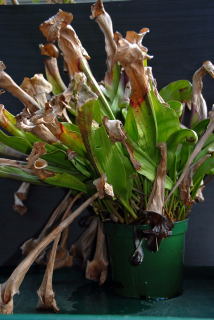
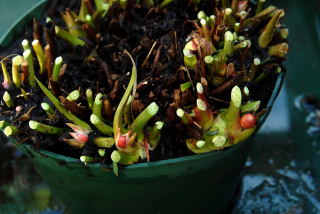
The plant shown here has reached the edge of its pot. The plant can be potted on to a larger pot. If a larger pot will not fit into your chosen container the plant can be divided. This is simply a matter of cutting the rhizome into sections.
Once the leaves have been removed the pitcher plant is ready to be returned to its container. The next stage in the life of your pitcher plant is to produce flowers. These are produced before the new pitchers in order that any bees do not get eaten by mistake.
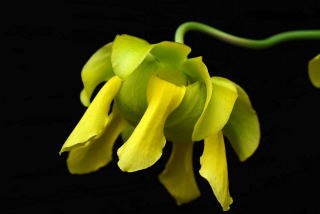
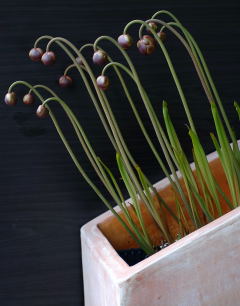
Once the flowers begin to fade it is recommended that they be removed. This prevents the plant wasting energy on seed production. However if you wish to collect your own carnivorous plant seed, leave them on.
The pitchers will be fully developed by now and free to dine on any passing insects.
.

